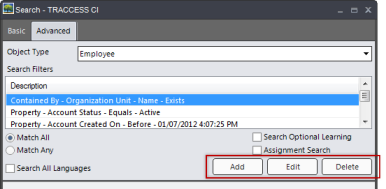
|
|
|
|
Managing Search Filters (Add, Edit, Delete)
The advanced search involves adding filters to an object type you are searching for, so you can return more refined results. There are four filter types: Property, Contains, Contained By, and Assigned To. Once you have added your filters, they can be easily managed. To learn more about the advanced search functions and how to conduct a search, visit Advanced Search.
Use the Add, Edit, and Delete buttons on the Advanced Search dialog to manage your filters:

You can add as many search filters as you like. The more filters you add, the more refined your search results will be; however, if you find that you are returning no results, you may want to review your filters and see if there is anything causing a block in your results.
Before you add a filter, you must choose an Object Type in the Search dialog under the Advanced tab:

Then click the Add button to add a filter from the Search Filter dialog.
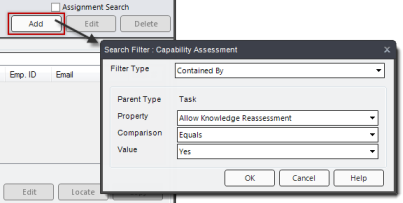
Click OK. And your filters appear in the Description box of the Search dialog. You can continue adding more filters.
When you have added more than three filters a scrollbar appears. Use the scrollbar to browse through your filters:

For step-by-step instructions on conducting an Advanced search, which includes adding filters, visit Conducting an Advanced Search.
To edit a filter:
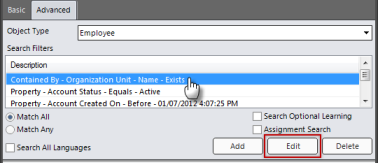
To delete a filter:
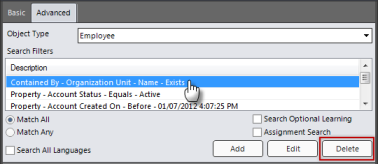
There are four filter types: Property, Contains, Contained By, and Assigned To; however, the types that are available in the Filter Type dropdown menu depends on the type of object your are searching for. The Filter Type also determines which filters you see.
Note: The "Assigned To" filter type is only available when the "Assignment Search" checkbox is enabled in the Advanced tab of the Search dialog.
Choosing the "Property" Filter Type allows you to search according to a property that is associated with the object.
For example, if your Object Type is Capability Assessment, you can search for only the Capability Assessments that are set as "online."
You can see how this example would look in the Search Filter:
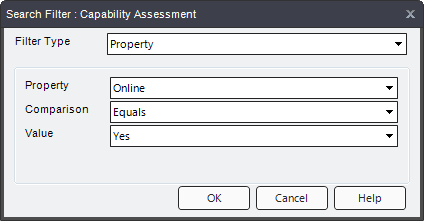
When using the "Property" Filter Type, the Property dropdown menu will show a variety of items dependent on the Object Type you have chosen. Each Object Type has its own unique properties. The Property chosen will also affect the Comparison and Value dropdown menus (and in some cases, there will be no Value dropdown menu). In the example of choosing the "External URL" property, when "Exists" is chosen for the Comparison, there is no Value; however, when "Equals" is chosen, a Value field appears, allowing you to enter a custom value:

Choosing the Filter Type "Contains" allows you to search for an object based on an object it contains. This searches for immediate child objects only.
For example, searching for Tasks that contain Knowledge Assessments that are "offline."
You can see how this example would look in the Search Filter below:
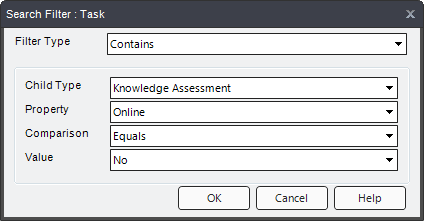
When using the "Contains" Filter Type, you will always see the Child Type dropdown menu. This identifies what immediate object that is associated with the Task. The Property, Comparison, and Value menus will vary dependent on the Child Type chosen.
Choosing the Filter Type "Contained By" allows you to search for objects based on its parent object. This works for immediate parent objects only.
For example, you could filter your search, so that you return results that only show employees who are members Organization Units that are named with the prefix "UE."
You can see how this example would look in the Search Filter below:
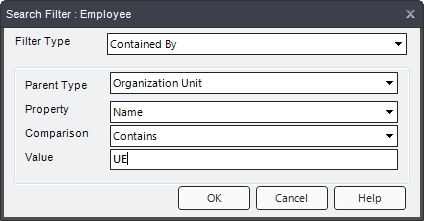
Choosing the "Assigned To" Filter Type allows you to search for objects based on the objects they are assigned to.
To access this Filter Type, first enable the Assignment Search checkbox on the Advanced tab in the Search dialog:
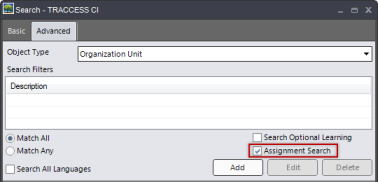
Once you have enabled the Assignment Search, you will have four Object Types to choose from: Organization Unit, Process, Process Set, and Task. When you click the Add button, the Search Filter dialog appears, and the Filter Type is set to Assigned To.
An example of an Assigned To search is searching for Tasks that are assigned to employees who have a rank of Fire Fighter.
You can see how this search would look in the Search Filter below:
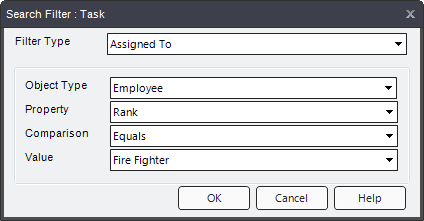
Additional Help: